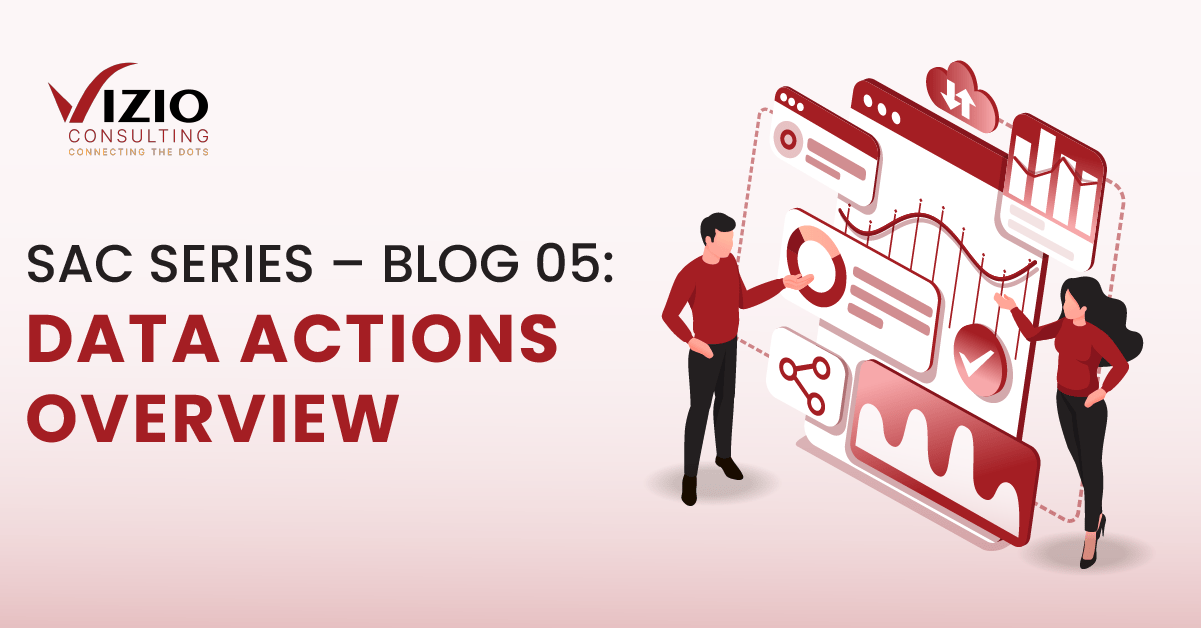Welcome to VIZIO’s blog series on SAP Analytics Cloud (SAC). This series will include explanations of the various functionalities, tools, features, and methodologies that are at the disposal of SAC application developers.
In this episode, we will be talking about one of the essential SAC tools for planning: Data Actions
Intro
Data action is one of the planning tools of SAP Analytics Cloud (SAC) that allows data changes to the model data. These are flexible tools that automate the execution of planning functions in a sequential, step-by-step manner. In this way, the results of the prior steps in data actions are observable in the subsequent steps before the latter are executed. You can also define the execution scope at each step of the data action to filter out the region of data not required for the current planning function.
The data actions are designed by modelers while their execution is performed by the planners. To create a data action, go to Home -> Navigation Bar -> Data Actions -> Create New Data Action (Fig 1.01 (a))

Fig 1.01 (a) – Creating a Data Action
There are multiple types of data action steps at the disposal of SAC users, each of which is briefly explained below:
- Copy Action
- Cross Model Copy Action
- Advanced Formula Action
- Allocation Action
- Embedded Data Action
- Conversion Data Action

Fig 1.01 (b) – Adding Steps to Data Action
Copy Action
The Copy Action step is used to copy data within the same model. This process is based on a set of scope-defining rules, filters, and aggregation settings.

Fig 1.02 – Add Copy Action Step
CASE STUDY:
The planner wants the sale numbers for the year 2021 to be copied to 2022 for Products X and Y. The modeler designing the data action for this requirement will define the scope of execution as follows:
Source Year: 2021; Products: X & Y, Measure: Gross Sales
Correct design and execution of the data action will produce a result like this:
| Gross Sales (CAD) | FY 2021 | FY 2022 |
| Product X | 10,000,000 | 10,000,000 |
| Product Y | 20,000,000 | 20,000,000 |
| Product Z | 25,000,000 | – |
Cross Model Copy Action
Unlike the Copy Action step which allowed data copy within the same model, the Cross Model Copy Action, as the name suggests, allows copying data from one model to a different model. This process, too, is based on a set of scope-defining rules and filters. The mapping of data between dimension members can be either a manual or an automated process.

Fig 1.03 – Add Cross Model Copy Action Step
CASE STUDY:
The planner wants to copy the updated FY 2021 marketing expenses for Product X, contained in the Marketing Costs Model, for FY 2021 of another model called Net Income which contains measures for marketing costs. The modeler designing the data action for this requirement will define the execution scope as follows:
Source Model: Marketing Cost Model, Target Model: Net Income; Date Scope: FY 2021; Measure scope: Marketing Costs.
Correct design and execution of the data action will produce the following results:
| Products | Marketing Costs (before update) FY 2021 (Source Model) |
Net Income (before the update) FY 2021 (Target Model) |
Marketing Costs (after update) FY 2021 (Source Model) |
Net Income (After Cross Model Copy) FY 2021 (Target Model) |
| Product X | 10,000,000 | 50,000,000 | 5,000,000 | 55,000,000 |
| Product Y | 20,000,000 | 75,000,000 | 18,000,000 | 75,000,000 |
| Product Z | 25,000,000 | 80,000,000 | 20,000,000 | 80,000,000 |
Advanced Formula Action
For more complex planning functions, the Advanced Formula data action step is suitable for executing the process with the help of a script containing transformations and calculations to apply the defined scope of data to the target model.

Fig 1.04 – Add Advanced Formula Action Step
For example, you can calculate the opening and closing balances of Assets in the balance sheet for 5 years based on the fluctuations in the Fixed Assets numbers. This can be achieved by embedding the calculation between a time loop that will calculate the opening and closing balances of one year, then repeat the calculation process for the next 4 years.
Allocation Action
Allocation data action steps are used to distribute the data/values from the source model dimension members to the dimension members of the target model utilizing driver values or direct assignment
Note: Before adding the allocation step as a data action step, the allocation step to be used first needs to be set up.

Fig 1.05 – Add Allocation Data Action Step
Embedded Data Action
This data action step is useful in scenarios where you want another data action to be a step or part of the sequence for the data action you are working on. By merging these steps with dynamic parameters, these data actions are reusable where the planner can choose different sources and target members

Fig 1.06 – Add Embedded Data Action Step
Conversion Data Action
If your models have measured, the Conversion data action can be used to copy data between measures while applying currency conversion.

Fig 1.07 – Add Conversion Data Action
StepNote: Conversion Data Action Steps are available only for those models which have measures and have currency conversion enabled in the Model preferences=-098
Reach out to us at info@vizioconsulting.com to learn more!

